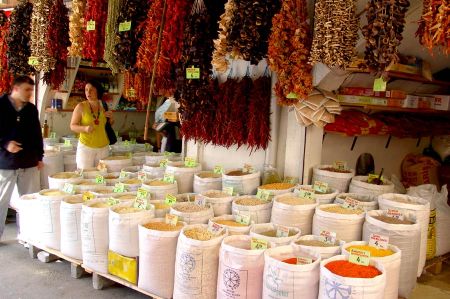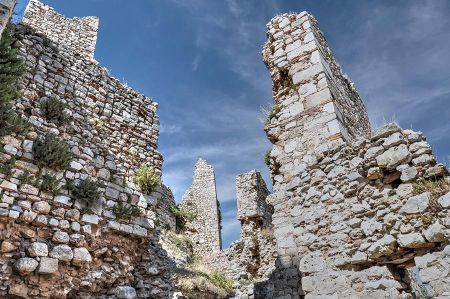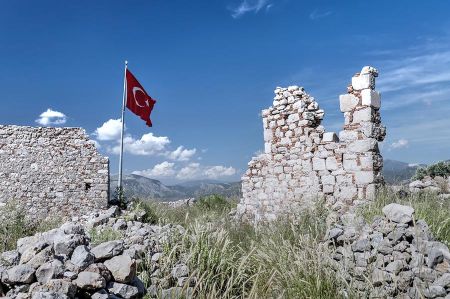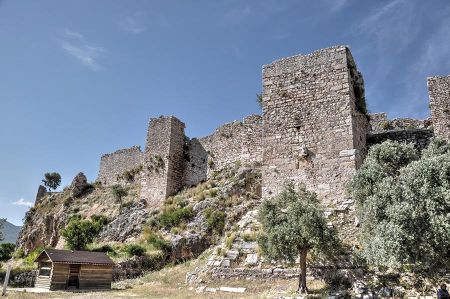Milas and the Becin Fortress
- Written by Portal Editor
Ancient Mylasa, today Milas, was one of the most important cities in the interior of Caria. Early, insufficiently published finds date from the late Bronze Age, including some fragments of Mycenaean clay vessels, probably from the 15th to 13th/12th centuries BC.
Mylasa was briefly part of the Athenian League in the 5th century BC and was the seat of the Carian rulers from the Hecatomnid dynasty in the 4th century before Maussolos moved his seat to Halicarnassus, today's Bodrum, around 360 BC. In the Hellenistic period, Mylasa belonged to various empires one after the other. During the Parthian invasion in 40 BC, it was badly devastated and no longer had much importance during the Roman Empire, even though it became the seat of a Christian bishop in late antiquity. Milas later became the capital of the Beylik of the Mentese.
Mylasa can possibly be identified with the city of Mutamutašša, which is mentioned several times in Hittite sources.
The old caravanserai of Milas
 The city of Milas has a well-known weekly market, which not only offers tourists a picturesque view, but is also a source of first-class and inexpensive olive oil (the surrounding area is a single olive area). In addition to old Turkish houses, craft shops and caravanserais, two mosques from the 14th century are worth seeing, one of them with a gable minaret (Orhan Bey Camii, 1330), a very well-preserved Roman tomb from the 1st century BC, in a style similar to the Wonder of the World at Halicarnassus (Bodrum), and an archaeological museum with pieces from pre-classical, classical, Hellenistic, Roman, Byzantine and Ottoman periods.
The city of Milas has a well-known weekly market, which not only offers tourists a picturesque view, but is also a source of first-class and inexpensive olive oil (the surrounding area is a single olive area). In addition to old Turkish houses, craft shops and caravanserais, two mosques from the 14th century are worth seeing, one of them with a gable minaret (Orhan Bey Camii, 1330), a very well-preserved Roman tomb from the 1st century BC, in a style similar to the Wonder of the World at Halicarnassus (Bodrum), and an archaeological museum with pieces from pre-classical, classical, Hellenistic, Roman, Byzantine and Ottoman periods.
 The building known as Uzunyuva ("Long / High Nest") was previously somewhat hidden. The single Corinthian-type column standing on a high base was previously thought to be the remains of the Temple of Zeus Karios. However, Turkish archaeologists learned of a burial chamber located deep beneath the base; the excavations that followed produced remarkable findings. The building was probably a precursor to the Mausoleum of Halicarnassus, the tomb of Maussolos. Based on the magnificent wall paintings and the figurative representations of the sarcophagus found in the burial chamber, it is assumed that Maussolos built the building for his father Hekatomnos.
The building known as Uzunyuva ("Long / High Nest") was previously somewhat hidden. The single Corinthian-type column standing on a high base was previously thought to be the remains of the Temple of Zeus Karios. However, Turkish archaeologists learned of a burial chamber located deep beneath the base; the excavations that followed produced remarkable findings. The building was probably a precursor to the Mausoleum of Halicarnassus, the tomb of Maussolos. Based on the magnificent wall paintings and the figurative representations of the sarcophagus found in the burial chamber, it is assumed that Maussolos built the building for his father Hekatomnos.
 Remains from the Hellenistic period can be found on the site, including a temple from the 4th century. A Byzantine church indicates that the settlement existed until the Middle Ages - but its minor importance is indicated by the small dimensions of the church. According to a contemporary Italian source, its name was Pezona. Towards the end of the 13th century, it was captured by the Menteşe Beylik, a principality founded by a Turkmen tribe. Beçin became the capital of the beylik and grew rapidly. In 1333, Ibn Battuta visited Beçin, describing it as a newly founded town and mentioning its houses and mosques. Most of the surviving monuments date from the 14th century. In the 15th century, the Beylik of Menteşe was annexed by the Ottoman Empire. A hint of the town's later decline can be found in Evliya Çelebi's account of his visit there in the mid-17th century: he wrote that the town had no hammam, but excavations have uncovered the remains of five hammams. A settlement continued to exist on the site until the 1980s.
Remains from the Hellenistic period can be found on the site, including a temple from the 4th century. A Byzantine church indicates that the settlement existed until the Middle Ages - but its minor importance is indicated by the small dimensions of the church. According to a contemporary Italian source, its name was Pezona. Towards the end of the 13th century, it was captured by the Menteşe Beylik, a principality founded by a Turkmen tribe. Beçin became the capital of the beylik and grew rapidly. In 1333, Ibn Battuta visited Beçin, describing it as a newly founded town and mentioning its houses and mosques. Most of the surviving monuments date from the 14th century. In the 15th century, the Beylik of Menteşe was annexed by the Ottoman Empire. A hint of the town's later decline can be found in Evliya Çelebi's account of his visit there in the mid-17th century: he wrote that the town had no hammam, but excavations have uncovered the remains of five hammams. A settlement continued to exist on the site until the 1980s.
Monuments in the town
 The Ahmet Gazi Madrasa, named after the bey who commissioned it, dates from 1375 according to the Arabic inscription above its entrance. Although the entrance portal has the components of a traditional Seljuk-era portal, it has details reminiscent of European Gothic architecture, possibly indicating an influence from the Menteşe Beylik's trading activities with the Aegean islands, Italy and southern France (the bey is referred to in the inscription as the "Sultan of the Coasts"). Modern reconstruction work has restored large sections of the entrance facade on either side of the portal. The madrasa has eight chambers and two iwans leading directly onto a rectangular courtyard (the usual portico is absent here). The tomb of Ahmet Gazi is in the main iwan, and an adjacent tomb may be that of another Menteşe ruler - Shujaeddin Bey.
The Ahmet Gazi Madrasa, named after the bey who commissioned it, dates from 1375 according to the Arabic inscription above its entrance. Although the entrance portal has the components of a traditional Seljuk-era portal, it has details reminiscent of European Gothic architecture, possibly indicating an influence from the Menteşe Beylik's trading activities with the Aegean islands, Italy and southern France (the bey is referred to in the inscription as the "Sultan of the Coasts"). Modern reconstruction work has restored large sections of the entrance facade on either side of the portal. The madrasa has eight chambers and two iwans leading directly onto a rectangular courtyard (the usual portico is absent here). The tomb of Ahmet Gazi is in the main iwan, and an adjacent tomb may be that of another Menteşe ruler - Shujaeddin Bey.
 Kizil Han or Kızılhan ("Red Khan"), a caravanserai, is a two-story building and one of two hans still in existence in Beçin. It is plain and unassuming and partially destroyed, with the upper floor having collapsed.
Kizil Han or Kızılhan ("Red Khan"), a caravanserai, is a two-story building and one of two hans still in existence in Beçin. It is plain and unassuming and partially destroyed, with the upper floor having collapsed.
Büyük Hammam (the "Great Bathhouse") is one of five hammams that once existed in the city next to Milas. All are now ruins. Büyük Hammam must once have been one of the most imposing buildings in the city - although most of its roof has since collapsed. Excavations have uncovered its interiors and revealed its original floor, which is paved with marble blocks.
Worth seeing in the area are Labraunda (Labranda), an old cult site of Zeus Labraundos in the mountains, Euromos near the road to Selimiye in an olive grove - one of the best preserved temples in the surrounding area (half of the 32 Corinthian columns are still standing), and on the eastern edge of the town on a volcanic cone Peçinkale, the castle of a pre-Ottoman clan that once ruled southwest Anatolia.
A little further towards Izmir are Lake Bafa and the Latmos Mountains with Herakleia on the Latmos and other, not easily found sights. Northeast of the lake, on an overhang in the east of the Latmos, the Hittite rock inscription on the Suratkaya is carved.
The castle of Becin near Milas
 The castle of Becin was founded in the middle of the rocky plateau south of the town of Beçin on the road between Milas and Ören. During the Byzantine heyday, the castle overlooked the entire Milas plain. A little later, when Menteseogullari ruled the region, the castle was completely restored.
The castle of Becin was founded in the middle of the rocky plateau south of the town of Beçin on the road between Milas and Ören. During the Byzantine heyday, the castle overlooked the entire Milas plain. A little later, when Menteseogullari ruled the region, the castle was completely restored.
The King of Menteseogullari made Milas his capital and shortly afterwards he himself moved to Beçin Castle, as it was much easier to defend than his previous residence. The original name of the city came from Italy and is given as Pezona in local sources, and only later in Islamic sources does the name Beçin appear.
 Beçin Castle was completely restored in the 1970s and then opened to visitors. Even today, you can see the ruins of a bathhouse and some cisterns surrounded by high walls in the castle. In the inner castle, about 200 meters further up the fortress, you can see other ruins of the former settlements, such as a columned Roman tomb, a Turkish tomb, a Byzantine chapel, an Islamic school from the Menteseogullari era, some mosques and other buildings.
Beçin Castle was completely restored in the 1970s and then opened to visitors. Even today, you can see the ruins of a bathhouse and some cisterns surrounded by high walls in the castle. In the inner castle, about 200 meters further up the fortress, you can see other ruins of the former settlements, such as a columned Roman tomb, a Turkish tomb, a Byzantine chapel, an Islamic school from the Menteseogullari era, some mosques and other buildings.
Please also read:
